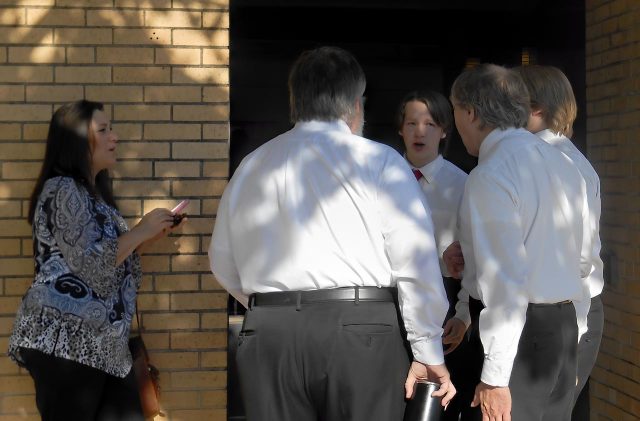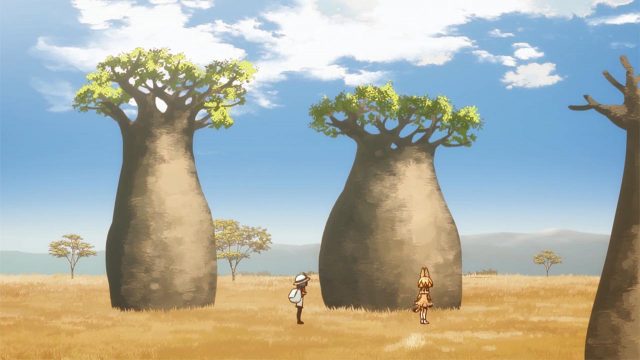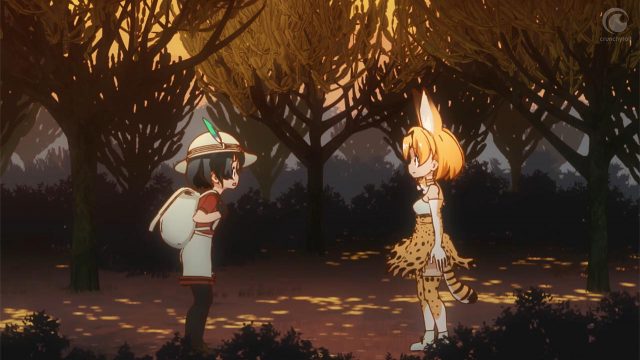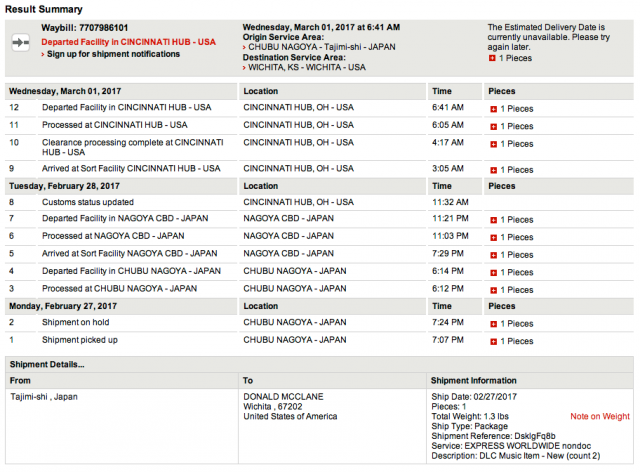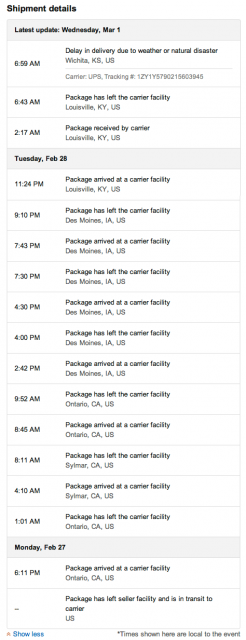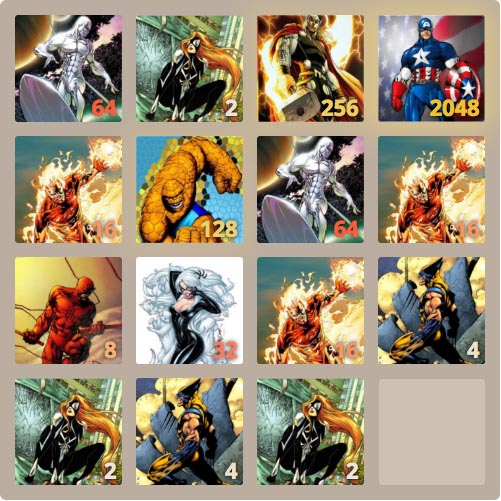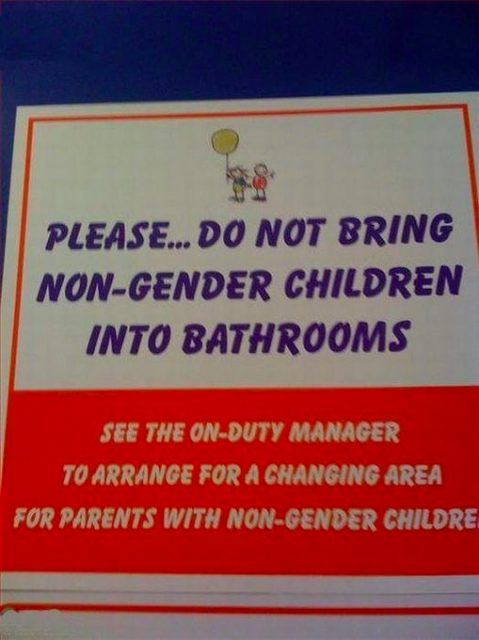A barbershop quartet singing “God Bless America” outside a television station.
Category: Whatever
Warning
Don’t peruse the cactus pictures here while you have a tab open to the Mesa Garden seed list.
Miscellany
I watched the first episode of Kemono Friends, the post-apocalyptic children’s show that allegedly is insanely popular in Japan. I didn’t dislike it as much as Pete did, but I doubt that I’ll watch more, even if it does feature baobabs (above) and tree euphorbias (below).
*****
Although there are innumerable Alices in anime, the most Carrollian show of them all never mentions her. Instead, we have Ami, who finds a door to “Animal Yokocho” in the floor of her new bedroom. Things are done differently in AniYoko. Animal Yokocho is nominally a children’s show, and it’s okay for kids, but adults will better appreciate the absurdities. This celebration of friendship, nonsense and emotional blackmail probably will never be licensed for North America.1 However, I recently discovered that the first third of the show is available subtitled on youTube.
*****
Here’s a helpful article that walks you through registering and making purchases at Amazon Japan. One important detail it omits is that you cannot download music to addresses outside of Japan.
*****
Saturday I placed orders with both Amazon Japan and Amazon USA. Which will arrive first? This is how matters stood at 7:30 this morning:
I expect both will arrive tomorrow.
Update: We have a winner.
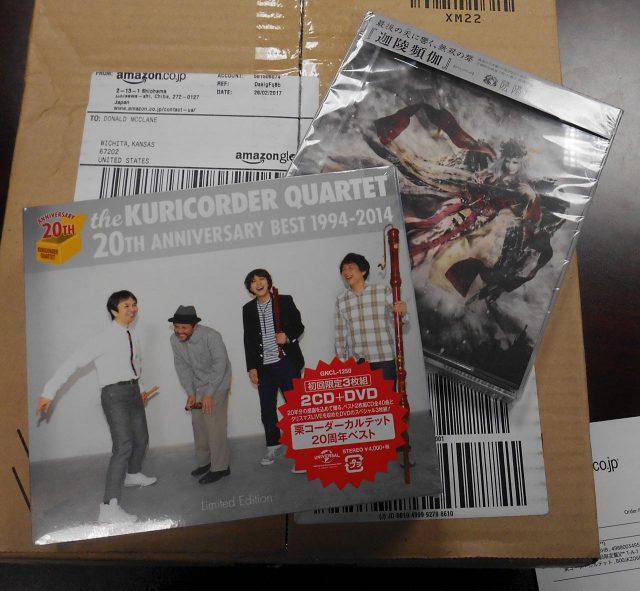
I suppose there’s a logical reason for this …
… but I don’t see it.
Some years back, Amazon.com sent a package from its (now defunct) Coffeyville warehouse to Wichita, a distance of about 140 miles, by way of Austin, Texas. I didn’t understand that, either.
Continue reading “I suppose there’s a logical reason for this …”
Warning
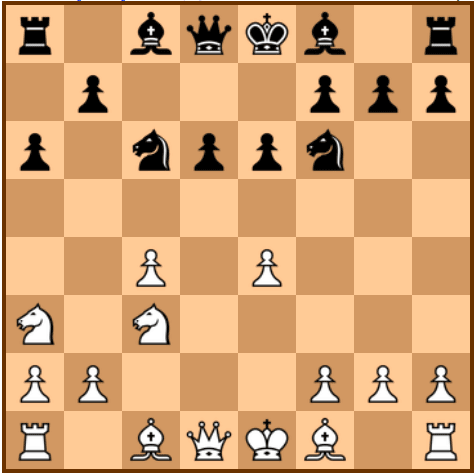
I stumbled across another dangerous waste of time: Chessgames.com. Think very carefully before you click.
Like most chess websites, it uses algebraic notation, which I can’t follow as easily as “P-K4.” However, it also has a “viewer” which allows you to step through each game on a virtual board.
A couple of well-known games in the archive there: Adolf Anderssen vs Jean Dufresne (1852); Anatoly Karpov vs Garry Kasparov (1985). There are more fireworks in either than during the Fourth of July.
Update: an interesting short story, possible connected with the chess position above1: “Master Jacobsen.”
Update II: Lord Dunsany was a pretty good chess player. Here’s a curiosity, a chess game between Capablanca and Lord Dunsany. Dunsany wrote a chess story of some note, “The Three Sailors’ Gambit.”
There is a fair amount of chess-inspired fiction. My favorite, aside from Through the Looking Glass, is Victor Contoski’s “Von Goom’s Gambit.” First published in Chess Review in 1966, it occasionally turned up in fantasy anthologies years ago, though finding it now would be a challenge. If it’s online, I missed it. It’s worth looking for if you have access to a large fantasy and science fiction library.
For the record
Playing on a bit further to show as many different tiles as possible:
Missing are Spiderman (512) and the Hulk (1024).
This particular game is here, should you want to try it yourself. The keys to success are to keep the expensive, hard-to-match tiles all on one edge, with the highest scores in the corners where they won’t impede the action, and to pick a game that’s pleasant to look at. I rather like the 32 tile, despite the girl’s odd proportions and posture.
Odds and ends for a chilly December day

Dear [Beautiful but Evil Space Princess],
Every time I capture the hero, I get this overwhelming urge to spill the entire plan, including the way out. How can I stop myself from giving it all away?
Sincerely,
Evil Underlord who can’t quite make the big leaguesDear Under,
Oh, Sweetie. This is a compulsion written into you by the author. You must use aversion therapy. Have one of your underlings dress up as the hero, and when you start spilling things, force yourself to do something really distasteful. I don’t know, pet a puppy or give sweets to children or something, until you break the compulsion.
It’s all right. If you manage to cure yourself, you can blend the puppies into a nice smoothie afterwards and it will make you feel much better.
I’m not a professional political scientist or sociologist. Then again, neither were Washington, Adams, Jefferson and that crowd ….
The election of Trump is, in many senses, stupid. However, it is far, far wiser and more in keeping with the idea that we, the people, are the defenders of the Republic to elect Trump than to elect someone who is beloved of Harvard. On the scale of errors one can make in a Republic, electing an arrogant and impulsive side-show barker is far to be prefered to electing someone whose fundamental goal is making elections irrelevant.
… humans have never had to deal with the problems that come from too much food and too much free time to consume it. We really have no idea what will come from it and how it will hurt or help society. There could very well be a huge upside to having lots of fat people. Perhaps when the zombie apocalypse comes, the zombies will eat the fat people and be satisfied, leaving the rest of us to regroup.
When I’m ruler of these lands, the people responsible for embedded, autoplay video will be torn to pieces and fed to the dogs.
Video meliora, proboque; Deteriora sequor:
I’ll never forget when John Updike reviewed a book on how FDR’s policies lengthened the Great Depression. Updike basically said that because FDR cared, and was trying, that was worth more than shortening the Depression.
Via Dustbury, who also notes that
That word “bipartisan” should set off an alarm: it almost always means that both sides are in cahoots and Up to Something.
A bit of spirited horticultural history, from a comment at an AoSHQ food thread:
One food arena where the US used to be the best in the world and is now near the bottom of the pack is cider (i.e. alcoholic fermented cider.)
Back in the Revolutionary War era cider was the #1 drink in the nation, far surpassing beer or wine or hard liquor. And people had planted the right kind of apple trees all over the country (as it existed then), so there was always a big supply of the raw material.
In fact, Johnny Appleseed didn’t go around planting edible apple trees — he went around planting cider apple trees! A detail that is now lost to most people’s imaginations of history.
“But wait,” you’re saying, “there’s a difference between edible apples and cider apples?”
Yes indeed. There are three fundamental “types” of apples:
“Sweet apples,” which is what we now think of simply as “apples” — the big crunchy sweet kind that you can eat.
“Sour apples,” now mostly known as “crabapples,” which are mostly useless except for making things with their pectin.
“Bitter apples,” now mostly unknown in the US, but still planted widely in France and England. THESE are the apples you are supposed to make true cider out of. As the name implies, they’re slightly too bitter to eat, but their chemical makeup is absolutely perfect for fermenting a delicious kind of apple cider, a process during which the bitterness goes away.
If you’ve ever tasted true cider made from bitter apples (which is what they serve you in Somerset and Normandy), you’ll know that cider made from sweet apples is atrocious by comparison.
And that’s the tragic part of our story.
Because of the arrival of so many German and Bohemian and Polish immigrants in the second half of the 19th century in the US, beer started to surpass cider in popularity nationwide, and then when Prohibition hit, cider production was stopped entirely. And what happened was that ALL — or almost all — the bitter apple trees in the United States were left to die or were torn out and make room for more useful trees.
So that by the time Prohibition ended, there was no longer any way to make true cider in any quantity, and as a result beer took over the casual drinking market almost 100%. Wine only started to make inroads in the ’60s and ’70s. But cider remain completely forgotten by then.
That is until about 8 years ago, when the “small batch cider” renaissance started in the US, with small startups making cider from apples.
Sweet apples, that is — because that’s all that we have in the US anymore! Yuck!
Cider made from sweet apples is just wrong to a true cider aficionado. So no matter how much effort these America cider microbreweries put into their product, it will never match up to French and British ciders.
In fact, until just a couple years ago, most American cidermakers didn’t even know about the existence of bitter apples and didn’t know they were doing it fundamentally wrong.
Finally a few people have wised up, and they’ve started planting bitter apple trees in the US again, but it will still be several years before they are up and producing in sufficient numbers to create enough true cider for the masses.
Until then, we must suffer with an inferior American product! Frowney face!
Green thoughts
Curiosities discovered while planning next year’s garden:
Got a spot in your yard where the drainage is lousy? Consider growing American pitcher plants (Sarracenia). The dead tree Park Seed catalogue says that they are easy to grow, though the more detailed online listing qualifies that claim.
If you have well-established ivy, you can grow ivy broomrape (Orobanche hederae), “An amazing, non-chlorophyll producing, parasitic plant, attaching itself to the roots of its host plant without actually harming it. Produces bizarely beautiful, orchid-like, purple-veined cream flowers on wax-like stems.”
There are a number of terrestrial orchids that you can grow from seed if you have the right conditions and plenty of patience. The technique for starting the plants is a bit different from what most gardeners are used to:
Do not sow seeds in pots or trays, they will not germinate. Just sprinkle directly onto undisturbed ground, or even a wild grassy area. Please be very patient as they are very slow indeed to come up and you will see no seedlings for at least a year. Do not move them until fully-grown as they grow best where they have chosen to germinate. Please be patient as they are worth the wait.
None of these are quite right for my little garden, though it would be interesting to experiment with orchids native to the prairie if I had more yard to work with.
I am considering growing a South American Loasa or two or three. The flowers are intricate and bizarre, perfect for stacked focus stereo macro photography. However, I need to be careful where I place them, because the plants sting. Chileflora offers many more species.
While looking for Loasa culture information, I discovered that they were well-known in Victorian England and were occasionally planted in gardens. (The illustration above is from an 1822 book describing exotics cultivated in Great Britain.) I gather that the plants can be treated as half-hardy annuals.1
Something I didn’t expect to find: Loasa lateritia socks. I suppose they’re wonderfully soft and warm when made with the right yarn, but I wouldn’t want to wear something with that name next to my skin.
Prairie Moon Nursery specializes in plants from the midwest and prairies. The genera that most interest me are best planted in the fall to germinate after winter, so I’ll probably place an order at the end of next summer.
On a different horticultural note: a discussion of the begonias in the tenth episode of Flip Flappers, a strange show that is getting stranger still and is likely the best show of the past few years.
Update: The eleventh episode of Flip Flappers focuses on white clover, such as you find in your lawn.
Second warning

I couldn’t resist making my own 2048 game, using images from the Girls und Panzer movie. Beware: this can be terribly addictive, and if you have work that must be done, do not click here.
Update: I made another one using images from GATE and a different online game maker.
(If you are unfamiliar with this sort of game, you play it by using the arrow keys on your keyboard to push the tiles around. There are eleven (2,048=2^11) different tiles; revealing the last two is not easy.)
Update II: There are orchids now, too.
Update III: And ballet.
Warning
Don’t click here if you have work to do.
(Via Pergelator.)
Update: Beware — Fillyjonk notes that there is a Pony version, too.
The topic of the day
Can schadenfreude be virtuous? Edward Feser considers the question.
Meanwhile, Daniil Simkin heads to work:
Need a distraction?
J Greely has a pleasant, not quite safe-for-work little puzzle for you.
More than enough about me
Medieval Otaku thinks I have one lovely blog and has tasked me with the following:
You must thank person who nominated you and include a link to their blog
You must list the rules and display the award
You must add 7 facts about yourself
You must nominate 15 other bloggers
Um, gee, thanks, I think, M.O.
Over the years, I’ve written about myself perhaps more often than is healthy, and it is difficult to find seven fresh facts worth mentioning. I’ll start with a little recycling. In the past, I’ve written
1. this
and
2. that.
There’s more about me
3. here.
What else? Let’s see….
You heard it here second
A couple of links for a tedious Wednesday morning:
The winners of the 2017 Nobel physics prize have been leaked. I’m disappointed that there was no acknowledgement of the pioneering work of Eddy and Dale.
If you ever wanted a scarf like that of Doctor #4, knitting directions are here.
Yes
(Via the Professor.)
Links in the time of hurricanes
It looks like the Brickmuppet will get a reprieve from Matthew. Down in Orlando, William Luse might not be as lucky. He links back to his posts from 2004, when Charley and friends paid visits to the Florida peninsula.
Update: The Brickmuppet’s luck ran out.
Derek Lowe recently added another post to his “Things I won’t work with” file, this one dealing with a feisty nitrogen compound (“Recall that this is the compound whose cocrystal with TNT is actually less dangerous than the pure starting material itself….”) and anhydrous hydrogen peroxide.
I am told that I barely talked at all until I was nearly four, though when I did start chattering, it was in complete sentences. I was perhaps fortunate that this was back in the dark ages, when autism was a rare and exotic affliction and few people had even heard of Asperger’s.

